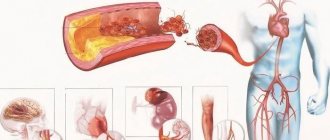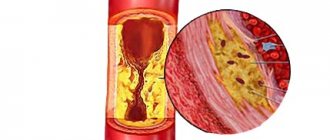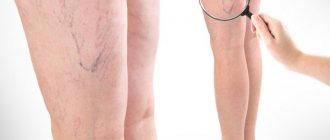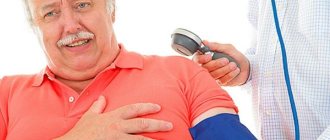Causes of leg vein thrombosis
Thrombosis (vein blockage) is the process of blood clots forming inside the veins, which attach to their walls and interfere with normal blood flow. Depending on the location, thrombosis of superficial and deep veins is distinguished. Interestingly, the process of blood clot formation is not initially pathological: a blood clot should form in response to vessel injury, preventing the development of bleeding. In such a situation, the body intensively synthesizes platelets and fibrin, “sealing” the damage. However, in some cases, this mechanism is triggered even if the vein wall has not been injured. What situations are we talking about?
- Hypercoagulation.
Expert opinionViolation of the drinking regime, poor nutrition, metabolic failures, elevated body temperature, the presence of cancer and chronic inflammatory processes in a person, taking oral contraceptives and some other medications - all this leads to the blood coagulation system over the anticoagulation system, increased blood viscosity and the possible formation of blood clots.
Vascular surgeon, phlebologist
Osipova Ekaterina Yakovlevna
- Narrowing of the lumen of the arteries. The development of this problem can be caused by the presence of atherosclerotic plaques in a person.
- Heart diseases. Atrial fibrillation, heart failure and other cardiac pathologies can negatively affect the condition of blood vessels and the composition of the blood.
- Inflammatory processes and injuries to the walls of blood vessels. The walls of the veins can become inflamed as a result of a violation of their integrity due to frequent injections, catheter installation, bone fractures, bruises and burns, and surgical interventions.
- Hypercoagulation. If a person remains in a sitting/lying position for a long time, there is a risk of developing blood clots in the veins of the legs.
- Overweight. Excessive body weight increases the load on the lower extremities, leading to poor circulation and creating preconditions for the development of thrombosis of the veins of the lower extremities.
why are blood vessels blocked?
Mechanism of blood clot formation
The process of blood clot formation is called thrombosis. The point of this process is to block the damaged area by denaturing protein and other blood elements.
The structure of the thrombus is designed to maintain normal blood flow, and its reliable adhesion to the vessel under normal conditions does not provide for separation.
In a similar article, we talk even more about what a blood clot is and how it breaks off.
Blood clots form in this way:
- From the damaged area on the vessel, substances begin to be released that inhibit processes that reduce blood clotting.
- Platelets begin to change their structure, and components (thrombin and thromboblastin) are released into the blood, promoting its clotting.
- Fibrinogen (a protein that promotes rapid platelet sedimentation) under the influence of thrombin is converted into a substance that is the basis of a blood clot and forms it in the form of a mesh of threads.
- Blood elements (erythrocytes, platelets, leukocytes) begin to accumulate in the cells of the thrombus mesh.
- The formation becomes denser over time.
- The process of thrombus formation is completed, and the damaged vessel is occluded.
Blockage (thrombosis) of veins in the legs: symptoms
The initial stage of the pathological process is usually asymptomatic, so many patients seek medical help when the disease reaches a late stage. The intensity of symptoms depends on a number of factors: the size of the blood clot, the number of thrombosed veins, lifestyle and the general health of the person.
Blocked veins in the legs: symptoms
The presence of thrombosis can be suspected by the following signs:
- Swelling and swelling of the lower extremities.
- Swelling of veins.
- The appearance of a pronounced vascular network and “stars”.
- The appearance of small pinpoint hemorrhages on the affected leg - petechial rash.
- A feeling of fullness and heaviness in the legs, increasing in the evening or after a long stay in an upright position. Unpleasant sensations are reduced if a person lies on his back and raises his legs above the level of his heart.
- The lower extremities acquire a bluish tint, and sometimes there is a feeling of numbness and tingling. The affected leg may also appear pale and cold to the touch.
- If thrombosis is accompanied by an inflammatory process and a person develops thrombophlebitis, an increase in local and general body temperature is possible.
Diagnostics
If suspicious symptoms are detected, the patient consults a phlebologist.
In addition to the external examination of the lower extremities, the specialist performs Doppler ultrasound of the venous vessels in the legs, which allows you to accurately determine the location of the blood clot and the depth of damage to the vein.
Based on the results of the study, the doctor determines the severity of the pathology and prescribes the correct treatment. If a blood clot breaks off and begins to move through the vein, the patient is urgently examined using new venography techniques. They allow you to track moving formations in the vessels.
Blockage (thrombosis) of veins in the legs: treatment
blockage of blood vessels
Therapy should begin with a consultation with a phlebologist and an examination. Diagnosis usually requires a visual examination, checking for pulsation, assessing the color, temperature of the limbs and their diameter. To detect the number of blood clots and assess their size, it is necessary to perform duplex ultrasound of blood vessels or, in some cases, perform MSCT with the introduction of a contrast agent.
!
To assess blood composition and the tendency to thrombus formation, a general blood test and coagulogram are prescribed.
Based on the data obtained, the doctor decides how to treat venous thrombosis in this particular case.
Treatment is designed to solve the following problems:
- Reduce blood viscosity.
- A safe way to eliminate a blood clot.
- If there is an inflammatory process, relieve inflammation.
For these purposes, medical and surgical methods are used:
- Anticoagulants. These drugs thin the blood and prevent the formation of new blood clots. They must be taken according to an individually developed regimen under the constant supervision of a physician, since an incorrectly selected dosage can lead to the development of bleeding. Some anticoagulants (such as warfarin) require regular INR blood tests.
- Thrombolytics. The action of drugs in this group is aimed at lysis (dissolution) of the blood clot and restoration of normal blood flow. It should be taken into account that treatment with thrombolytics has contraindications. They should not be taken after recent operations on internal organs, with severe arterial hypertension, the risk of internal bleeding, or in the presence of vascular diseases of the brain.
Blocked veins in the legs, treatment
- Venotonics. Drugs in this group are aimed at increasing vascular tone, eliminating congestion, and relieving swelling. They can be prescribed both for oral administration (in the form of tablets) and for external use (in the form of creams, gels and ointments). Particularly popular are products based on rutin and plant extracts (for example, horse chestnut).
- Non-steroidal anti-inflammatory drugs. These drugs are prescribed if thrombosis is accompanied by an inflammatory process and the patient develops thrombophlebitis.
- Surgical intervention.
Expert opinion
In modern medical practice, surgical treatment of thrombosis (thrombectomy) is resorted to if vein thrombosis cannot be eliminated by other methods. The operation should be performed under the guidance of experienced vascular surgeons. It is also possible to install a vena cava filter into the vein - a mesh trap that blocks the penetration of blood clots into the lungs.
Vascular surgeon, phlebologist
Osipova Ekaterina Yakovlevna
vein blockage
General principles of treatment
At the initial stage of the disease, doctors prefer conservative therapy. But you shouldn’t think that it can eliminate venous lumps and other manifestations of vascular problems. They can only be removed through surgery. Medicines are selected in such a way as to completely relieve the patient of pain and reduce the rate of blood clot formation. If medications don't help, doctors resort to installing capha filters and other surgical methods to treat the blockage.
How to treat blockage (thrombosis) of veins in the legs at home?
You should not completely replace medications prescribed by your doctor with the use of traditional recipes. “Grandmother’s” advice can act as an additional measure, but treatment of vein thrombosis should in no case be based solely on them.
blocked veins in the legs
To treat thrombosis at home, decoctions and infusions of herbs are used, which are taken orally and applied externally to the affected areas of the legs - as applications. Herbal medicines can also be used to prepare homemade ointments. What plants are suitable for fighting blood clots?
- Horse chestnut. This is one of the most famous traditional medicines that prevents the formation of blood clots. To prepare the tincture, wash a glass of chestnuts, chop them and pour 800 ml of vodka, then put them away in a dark place for 3 weeks. When the infusion is ready, it is used for oral administration. You can also prepare an ointment from chestnut cores. To do this, the horse chestnut fruits are peeled from the brown shell, the resulting kernels are dried in the oven, crushed and mixed with butter. The resulting ointment is stored in the refrigerator and used to rub the feet.
- Lemon and garlic. These products help thin the blood, so they are actively used in folk medicine to combat blood clots. To prepare the tincture, take a medium head of garlic and a large lemon, grind it in a blender or pass it through a meat grinder. The resulting pulp is placed in a jar, filled with warm water (not boiling water) and left for several days, after which a few sips are taken before each meal.
- Cranberries or blueberries. The berries are crushed in a blender or passed through a meat grinder, mixed with honey to taste and taken a tablespoon several times a day.
- Vinegar. For 50-60 ml of apple or grape cider vinegar, take 4 tablespoons of honey, mix until smooth, lubricate the legs with the resulting mixture, wrap with cling film and hold for about 15-20 minutes.
!
Thrombosis is a serious pathology and traditional medicine alone will not be enough to combat it. So if you decide to undergo treatment at home, do not forget to consult your doctor first.
Traditional recipes for the treatment of thrombophlebitis
Despite the safety of folk remedies for eliminating varicose veins, like any medicine, these methods have contraindications.
When a diagnosis of vein blockage is made, if the pathology is not in a severe stage, treatment should be comprehensive. If conservative methods do not bring the desired results, they resort to surgical intervention.
The main treatment process includes the following methods:
- The specialist prescribes drugs that thin the blood, dissolve the blood clot and prevent its re-formation. While taking medications, it is important to regularly do an INR test, which determines the rate of clot formation; depending on this, the dosages of prescribed medications are adjusted. Antibiotics may also be prescribed if there is a risk of inflammation. Find the best cure for blood clots in this article.
- If the patient is immobile, then the corner of the bed where the legs are is slightly raised.
- After pain relief, the doctor recommends exercise therapy under the supervision of a specialist.
- If necessary, the clot will be removed with a special catheter, which is inserted into a vein.
In acute stages of pathology, surgical treatment is resorted to. Sometimes special vena cava filters are inserted into large vessels, which prevent blood clots from getting to the heart and lungs.
There are also many traditional medicine recipes that can alleviate symptoms. However, lotions, infusions, and decoctions should be used only after consulting a doctor.
Since in the case of floating thrombosis, the clot can break off and begin to move through the vessel, which is fraught with dire consequences.
There are a large number of various recipes with which you can get rid of the diagnosis of thrombophlebitis; treatment with folk remedies provides a large number of effective methods. The use of certain methods depends on the form of the disease, its course and the general symptoms of the patient.
Often, in parallel with the use of methods for blood clots, other methods are used to relieve inflammation and improve the condition of the skin.
Diet in the fight against thrombophlebitis
Traditional methods of treating thrombophlebitis include a special diet. To get rid of the disease, it is necessary to thin the blood, so food should consist mainly of:
- oil (linseed, olive);
- Luke;
- garlic;
- sunflower seeds;
- cocoa;
- vinegar (apple);
- beets;
- melons;
- tomatoes;
- Hercules;
- cranberries;
- lemon;
- cherries;
- viburnum.
In addition, you need to consume a mixture every day: honey (1 tbsp), vegetable oil (2 tbsp), garlic (1 tsp).
Leeches in the treatment of thrombophlebitis
This method is suitable for the treatment of acute thrombophlebitis. The leeches should stick slightly higher from the diseased area (it is forbidden to place leeches on the veins). They help normalize bleeding and prevent blood from stagnating in the veins.
It is most effective to place leeches on both sides at a distance of 2 cm from the damaged vein. It is acceptable to do this procedure in a staggered arrangement at a distance of at least 6 cm based on the affected area; 6–15 leeches are needed.
Leeches should not be applied to the area under the knee, and care must be taken when placing them in the groin. If there is a purulent process, treating thrombophlebitis at home is prohibited.
Rubdown for thrombophlebitis
Rubbing with a tincture based on Kalanchoe helps well with thrombophlebitis. To prepare it you will need: 0.2 liters of vodka and 2 tbsp. l. Kalanchoe (leaves). The leaves need to be finely chopped and poured with vodka. You need to leave the wiping for about a week. The course of treatment is 90 days.
The procedure of wiping the affected areas with lard-based ointment can bring recovery closer to thrombophlebitis. After wiping with this mixture, the affected area should be bandaged for a day. To prepare such an ointment, you need to mix: melted lard, honey, laundry soap (liquid), ichthyol and Vishnevsky ointment, onion juice and aloe. Before wiping, cool the mixture to room temperature.
Thrombophlebitis that forms on the superficial veins can be treated with folk remedies by lubricating the legs with an alcohol tincture with the addition of acacia. And also the use of daily compresses: 2 tbsp. l. tincture diluted in 0.2 liters of boiling water (use after 2 hours).
A positive effect in the treatment of thrombophlebitis can be achieved by using an ointment based on mumiyo. This substance must be diluted in Vaseline (1:5). Use for wiping 2 times a day. For internal use there is the following recipe: mumiyo 8 g. mix with 0.5 liters of water. Drink 20 drops before meals.
Applications
A person suffering from thrombophlebitis, which has formed in the deep veins, requires a state of rest for at least 3 days. Such a warning can save you from breaking off a blood clot. When treating an acute form of thrombophlebitis, the first step is to apply compresses.
For a compress, you can use a cold wet towel, which is first recommended to be soaked in sea salt (1-1 tsp per 1 liter), it should be applied to the affected area for 30 minutes. It is recommended to take a 30-minute break after each adjustment.
An application for the treatment of thrombophlebitis, consisting of 2 layers, is recommended to be placed over the affected area. To prepare for the procedure, you need to wipe the sore spot with warm water, this will help open the pores. Then take herbs in equal parts: sage, string, bird knotweed, chamomile. The mixture (5 tbsp.) is filled with 1 liter of water, put on fire.
Boil the broth for several minutes, then reduce the heat to low and leave for 1.5 hours. Next, remove the broth from the heat and leave for about 3 hours. Fold the gauze into 4 layers, soak it in the cooled broth and wrap it around the affected area.
Compresses
The next step is to take the second piece of gauze, fold it into 4 layers and soak it in a solution of sea salt. Wrap this gauze over the existing 1 layer. You can use an elastic bandage or piece of clothing for fixation. This application must be kept for at least 4 hours. No insulation required.
This procedure must be carried out daily. If it is necessary to restore small vessels (between the fingers), you can apply the same application using a bandage instead of gauze. This method helps to quickly cure thrombophlebitis.
A decrease in inflammation in thrombophlebitis is observed when lilac (leaves), horseradish, snake knotweed, and broken cabbage leaves are applied to the sore spots, which should initially be lubricated with sunflower oil.
An alcohol tincture based on rowan, which must be diluted with water (1:3), is well suited as a compress for thrombophlebitis. You need to soak gauze in the mixture and apply it to the affected area.
This folk remedy for thrombophlebitis of the lower extremities helps get rid of the disease in a few months. Applying grated raw potatoes to the affected areas also gives a positive result. The resulting pulp should be wrapped in a bandage or gauze and left overnight.
Every day 3 times you need to make compresses using tomatoes. To do this, you need to cut the tomato and place it on the sore area until a burning sensation appears, then rinse with water.
Wormwood, ground and mixed with yogurt, is an effective method in the fight against edema due to thrombophlebitis. This paste should be applied to the affected area and left overnight.
What is the danger of blockage (thrombosis) of the veins in the legs if it is not treated?
Diagnosis of leg vein thrombosis and timely initiation of treatment are extremely important not only for maintaining health, but also for the life of the patient. After all, if a blood clot formed in a vein completely blocks its lumen, this can lead to an embolism. In turn, this condition can cause insufficient blood flow to the organs. For example, a blood clot that breaks off and blocks a pulmonary artery can lead to the development of a pulmonary embolism, a life-threatening condition that is often fatal.
What other complications should you be aware of in order to start treatment of thrombosis on time?
blockage of blood vessels
- If left untreated, chronic venous insufficiency may develop.
- The situation may be aggravated by the addition of inflammation to thrombosis - in this case, the patient develops thrombophlebitis.
- We should not exclude the possibility of developing decompensation of varicose veins - a condition that occurs when the deep veins in the legs are completely blocked. As a result, a person develops trophic ulcers - long-healing wounds that cause pain and serious discomfort.
blood vessels, disease
- The presence of blood clots negatively affects the appearance of the lower extremities, causing psychological discomfort to patients (especially women). Swelling and bluish tint of the legs can interfere with your personal life and negatively affect social adaptation. This creates a vicious circle: a person begins to feel embarrassed about his condition, tries to limit his social circle and go out as little as possible - as a result, this leads to a decrease in physical activity, which further aggravates the symptoms of thrombosis.
Correlation between diseases of the circulatory system and mortality from them
Causes of blockage
Thrombophlebitis is not an independent disease, but a consequence of disturbances in the functioning of the body. There may be several reasons for its occurrence:
- Congenital predisposition.
- High blood clotting. This pathology is formed as a result of impaired metabolism, cancer or liver diseases.
- Stagnation of blood in the vessels. This happens with varicose veins, prolonged immobility and when blood vessels are compressed.
- The venous walls are damaged. This can happen in cases of injury, surgery or after long-term injection treatment.
- Blood flow is disrupted. This is associated with long periods of sitting at a desk or standing.
Blockage (thrombosis) of a vein in the leg: what to do for prevention?
Rationalization of work and rest schedules, wearing special compression garments and correcting nutrition - all this has a beneficial effect on the condition of blood vessels and helps reduce the risk of thrombosis of the leg veins.
Preventative exercise
When the first symptoms of thrombosis appear, the patient is advised to reconsider his attitude towards physical activity. It is advisable to avoid staying in any static position for a long time - either sitting or standing, or lying down. During the day, you need to perform not very difficult physical exercises, and if this is not possible, then at least change your body position as often as possible.
Massage
As a preventive measure, you can practice self-massage, as it relieves the feeling of tightness and improves blood flow. However, remember that if you have thrombophlebitis with dilated and painful veins, you cannot do a massage.
foot massage
Compression underwear
Since one of the reasons for the development of blockage (thrombosis) of the veins of the lower extremities is varicose veins, wearing special compression products - stockings, tights, knee socks, elastic bandages - gives good results in the fight against this problem. Their use has a beneficial effect on the speed of venous blood movement. Each patient can choose the type of compression garment that suits them, depending on the level of pressure exerted by the product on the lower extremities.
compression underwear
Hirudotherapy
Installing medical leeches is an effective means of preventing varicose veins on the legs. The saliva of leeches contains a special component - hirudin, which is a natural anticoagulant. This substance reduces blood viscosity, improves blood flow in the lower extremities, and increases local and general immunity.
!
It is worth considering that hirudotherapy has contraindications (oncology, purulent processes, etc.)
In addition, the placement of leeches cannot be combined with the use of medicinal anticoagulants, as this can lead to complications, such as the development of bleeding.
Nutritional Features
A properly formulated diet allows you to lose excess weight, which puts additional pressure on the lower limbs, and also reduce blood viscosity. To achieve these goals, it is recommended to adhere to the following rules:
- Drink enough clean drinking water daily (up to 2 liters per day). Reduce coffee consumption, give up alcohol, limit, or better yet completely eliminate, milk and dairy products.
- Eat foods rich in heavy animal fats: fatty meats, butter, lard. Healthy sources of fat and protein are sea fish, seafood, vegetable oils (olive, flaxseed, MCT oil), replace milk with soy, almond, coconut.
- Completely exclude from the diet trans fats, margarine, smoked and salty foods, fatty sauces, chips and snacks, sweet carbonated drinks, milk chocolate, baked goods, bread, fast food.
- The daily menu should include vegetables, herbs, and fruits, which contain fiber.
- It is recommended to further enrich the diet with foods that include vitamins C, E and Beta-carotene. They are natural antioxidants that help reduce blood hypercoagulability. Such products include citrus fruits, kiwi, cranberries, raspberries, blueberries, apples, spinach, sea buckthorn, green tea, carrots, bell peppers, red beans, nuts, sunflower seeds. It is also worth eating foods that contain vitamin P (rutin). It maintains vascular tone at a high level, ensures their strength and elasticity. Contained in cherries, tomatoes, garlic, chokeberries, sorrel, buckwheat.
- Don’t forget about foods that increase the production of elastin, a protein that ensures the elasticity and strength of blood vessels. These include seafood, red grapes, and beef liver.
PLEASE NOTE: The recommendations described above are general guidelines. Therefore, it is advisable that the daily diet be compiled by a doctor taking into account an assessment of the patient’s general health.
Disease prevention
Blockage of veins is a condition of the body, the development of which is easier to prevent than to deal with its long-term treatment. For patients prone to this disease, doctors recommend wearing compression stockings. You need to put it on in the morning. With increased blood viscosity, the patient should take anticoagulants. Contrary to popular belief, thrombosis is very common in athletes. He was especially confirmed by people who, due to circumstances, abandoned training for a while and then returned to it. For such athletes, phlebologists recommend:
- drink more water during training;
- slowly reduce the intensity of exercise;
- Do a deep stretch after finishing your workout.
In general, recommendations for those with a tendency to thrombosis will be the same as for those with a predisposition to other diseases of the vascular system. A person should move more. If the work involves a long stay in a sitting or standing position, then about every 2 hours you need to do a warm-up. If you are prone to vein blockage, you should avoid hot baths and saunas and replace them with a contrast shower.
Atherosclerosis of the vessels of the lower extremities: symptoms, diagnosis and treatment
In healthy people, the lumen of the blood vessels remains clean, so the blood flows to the tissues without obstacles, supplying them with oxygen. The muscles receive enough nutrients for normal functioning. With atherosclerosis, cholesterol is deposited on the walls of blood vessels, which in itself narrows the lumen and causes inflammation of the wall, which provokes the formation of blood clots.
Over time, the amount of cholesterol increases and a cholesterol plaque forms. Sometimes it can break off and, together with the blood flow, enter smaller vessels, clogging their lumen. Over time, plaques become hard due to the deposition of calcium salts and can cause complete blockage of blood vessels (occlusion).
Typically, atherosclerosis of the legs develops slowly. The lumen of the vessels closes gradually, so at first the symptoms may be mild. However, as their lumen narrows, the tissues are increasingly supplied with oxygen and nutrients. Symptoms increase and become more pronounced. If atherosclerosis develops slowly enough, then small vessels have time to grow into the surrounding tissues, which take over the function of the affected artery. If it develops faster than the vessels have time to grow, they cannot compensate for the damage at a good level.
There are several stages of development of atherosclerosis of the lower extremities. Different researchers divide them differently. Let's consider one of the most detailed classifications according to A.V. Pokrovsky:
- Stage 1 – preclinical. It occurs when a lipid metabolism disorder occurs in the body. At this stage there are no obvious symptoms yet. Pain in the legs occurs only after a person has walked a long distance.
- Stage 2a – signs of atherosclerosis already appear. The legs begin to hurt after walking short distances, from two hundred to a thousand meters. A symptom of the so-called intermittent claudication appears: a person often stops due to pain to rest, however, as soon as he continues moving, his legs begin to hurt again.
- Stage 2b – pain in the legs appears over very short distances, a person cannot walk more than two hundred meters without stopping.
- Stage 3 - at this stage, pain appears at very short distances, and sometimes even at rest.
- Stage 4 – pain in the legs is constant, trophic ulcers and tissue necrosis develop.
Depending on where exactly the narrowing of the lumen occurs, atherosclerosis of the vessels of the lower extremities is divided into the following types:
- High-level occlusion - large vessels of the legs are affected, such as the aorta, iliac arteries, femoral arteries;
- Medium-level occlusion - the popliteal arteries are affected, as well as the blood vessels of the legs;
- Low-level occlusion - with this type of atherosclerosis, one of the arteries of the leg or foot is affected.
- Stage 1 – preclinical. It occurs when a lipid metabolism disorder occurs in the body. At this stage there are no obvious symptoms yet. Pain in the legs occurs only after a person has walked a long distance.
- Stage 2a – signs of atherosclerosis already appear. The legs begin to hurt after walking short distances, from two hundred to a thousand meters. A symptom of the so-called intermittent claudication appears: a person often stops due to pain to rest, however, as soon as he continues moving, his legs begin to hurt again.
- Stage 2b – pain in the legs appears over very short distances, a person cannot walk more than two hundred meters without stopping.
- Stage 3 - at this stage, pain appears at very short distances, and sometimes even at rest.
- Stage 4 – pain in the legs is constant, trophic ulcers and tissue necrosis develop.










